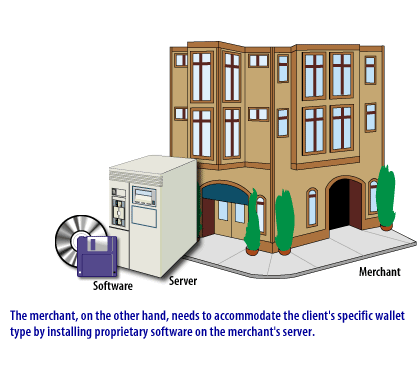| Lesson 4 | Digital cash |
| Objective | Use digital cash as a payment option. |
Digital Cash Payment Option used in ecommerce
Digital cash is the ability to represent "normal" currency electronically. A client uses special software that communicates with software located on your Web server.
Digital Cash Process
Consumers using digital cash must first load their electronic wallet[1] with money before they can spend it. This process converts the currency from conventional funds to electronic data. Once the buyer with a loaded wallet indicates a willingness to purchase something from the merchant's site, the consumer is then able to transfer a specified portion of the "electronic cash" from himself or herself to the merchant. Merchants can transfer funds from their wallets to their regular bank accounts.
Disadvantages of Digital Cash
Question: What are the disadvantages of Digital Cash?
Digital cash, also known as e-cash, is a digital form of currency that allows for online transactions without the need for physical cash. While digital cash offers many advantages, such as convenience and security, there are also several disadvantages to using this form of currency. Here are some of the disadvantages of digital cash:
In conclusion, while digital cash offers many advantages over physical cash, there are also several disadvantages to using this form of currency. These include limited acceptance, security concerns, dependence on technology, lack of privacy, and volatility. Before using digital cash, it is important to weigh these disadvantages against the potential benefits to determine if it is the right form of payment for your needs.
Digital cash, also known as e-cash, is a digital form of currency that allows for online transactions without the need for physical cash. While digital cash offers many advantages, such as convenience and security, there are also several disadvantages to using this form of currency. Here are some of the disadvantages of digital cash:
- Limited acceptance: One of the biggest disadvantages of digital cash is that it is not yet widely accepted. While many online merchants and businesses accept digital cash, it is not yet a universally accepted form of payment. This can limit its usefulness in certain situations, such as when traveling or making purchases in person.
- Security concerns: Digital cash is vulnerable to hacking and other cyberattacks. If a digital wallet or account is compromised, it can result in the loss of funds. Additionally, there is the risk of counterfeit digital cash being created and used.
- Dependence on technology: Digital cash requires a reliable internet connection and other technology, such as computers and mobile devices, to function. In areas with limited access to technology or in the event of a technological outage, digital cash may not be a viable form of payment.
- Lack of privacy: Digital cash transactions are often tracked and recorded, which can be a disadvantage for those who value their privacy. Unlike physical cash, which can be used anonymously, digital cash transactions leave a digital trail that can be traced back to the user.
- Volatility: Some forms of digital cash, such as cryptocurrencies, are known for their volatility. The value of these currencies can fluctuate widely, making it difficult to determine the value of goods and services being purchased.
In conclusion, while digital cash offers many advantages over physical cash, there are also several disadvantages to using this form of currency. These include limited acceptance, security concerns, dependence on technology, lack of privacy, and volatility. Before using digital cash, it is important to weigh these disadvantages against the potential benefits to determine if it is the right form of payment for your needs.
Digital Cash Benefits
Unlike the credit model, transactions using electronic funds are completed immediately, and the transactions have no cost. This immediacy makes the electronic money option attractive for companies conducting high-volume, low-dollar transactions, because many credit card companies require minimum charge amounts. Another advantage of digital money is anonymity for the consumer. Credit card transactions always involve a mechanism for tracing the transaction, and identification must be presented to prevent fraud. Properly implemented, digital money does not leave any trails.
The two primary vendors of digital cash on the Internet are DigiCash and CyberCash. We will look at CyberCash, the method it uses, and its implementation.
The two primary vendors of digital cash on the Internet are DigiCash and CyberCash. We will look at CyberCash, the method it uses, and its implementation.
Digital Cash Drawbacks
Digital cash options are less popular for three main reasons:- All potential clients have to load proprietary software on their systems.
- If your site doesn't support a certain proprietary software, clients will have to download and install new software.
- All potential clients will have to modify their behavior; rather than simply browsing the Web with Netscape Navigator or Microsoft Internet Explorer, they will have to access a separate application. This is often perceived as a hassle.
The following series of images below describe how electronic cash is used.
Digital cash Explained







You will learn about digital certificates in the next lesson.
[1]Wallet: The repository for digital cash. Wallet software resides on a client's computer. The client must "fill" a wallet before using it on an e-commerce site. Also, the e-commerce site has to support the particular wallet software the client is using.